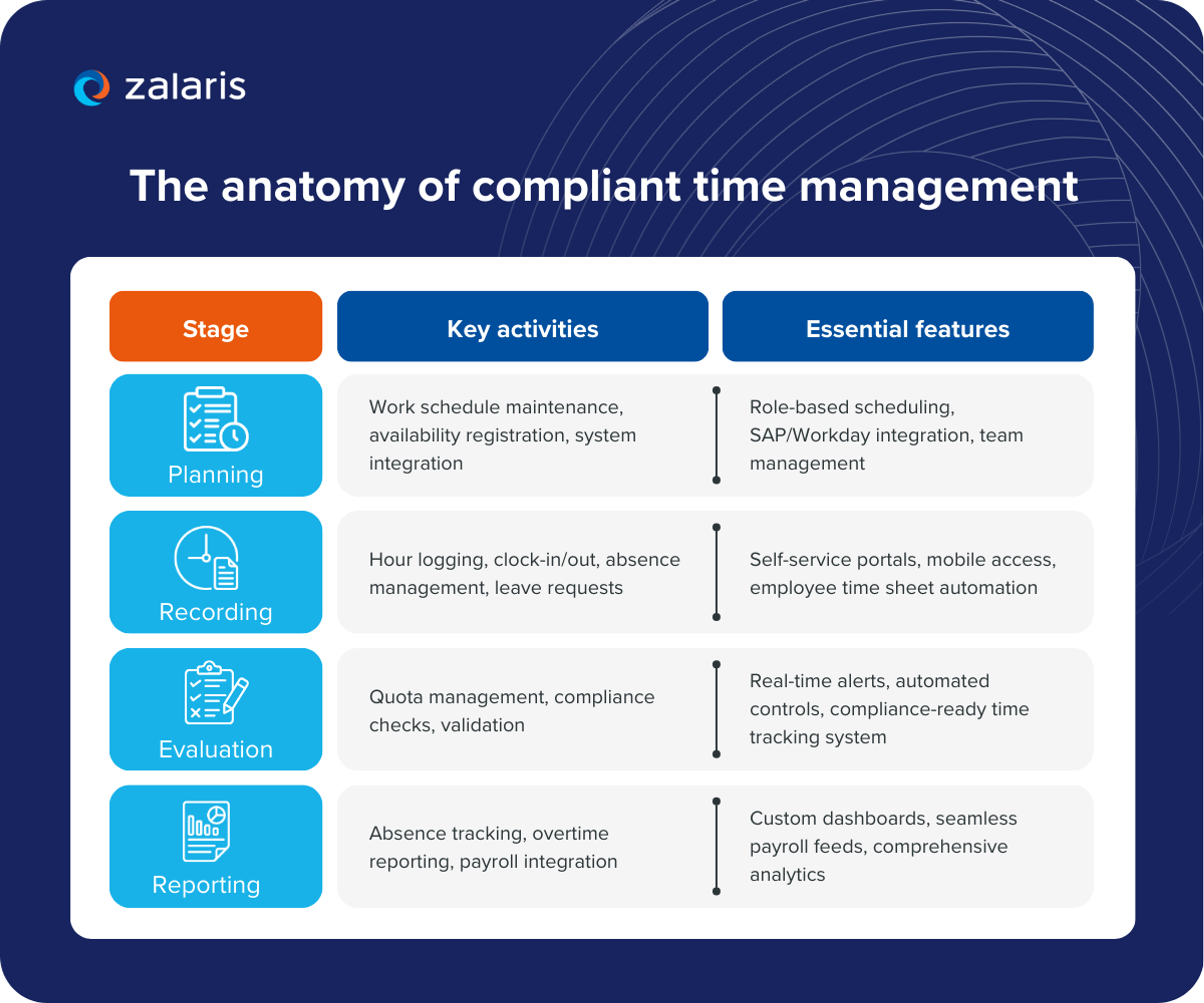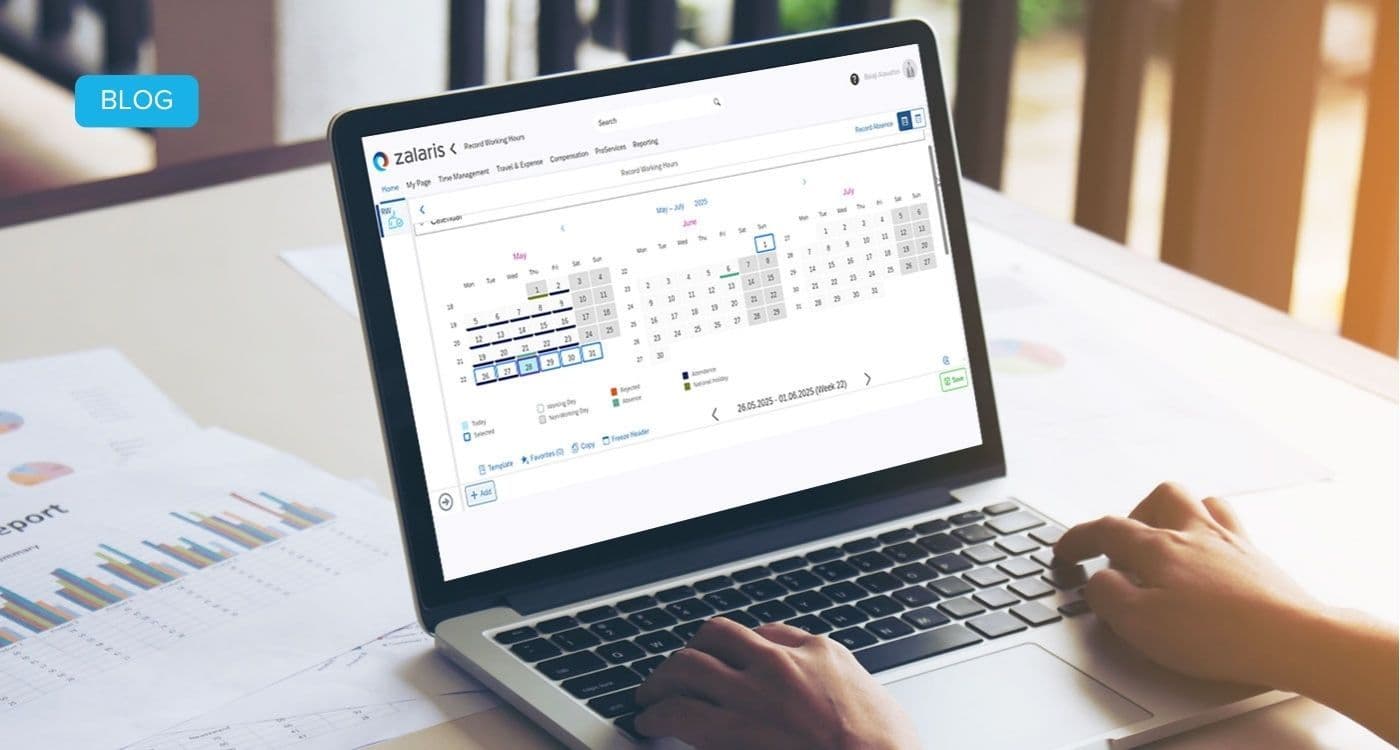Is your organisation ready for the new era of global time compliance?
Modern workforce management extends far beyond simple hour tracking. In 2025, organisations must navigate complex local laws, collective agreements, and flexible work patterns while maintaining compliance and operational efficiency. This guide explores the key challenges and demonstrates how the right time and attendance system can transform your business.
Liam Clark

Why time compliance is now a boardroom priority
Global expansion, hybrid work, and evolving regulations have made time tracking solutions a strategic necessity. For HR directors, operations managers, and IT leaders, the risks extend beyond simple administrative concerns.
Regulatory fines for non-compliance can reach millions, damaging both finances and reputation. Manual processes waste valuable resources and increase error rates while creating compliance gaps. Disconnected systems prevent organisations from gaining the visibility needed for informed decision-making and quick response to regulatory changes.
The European Working Time Directive sets a 48-hour work week limit, but enforcement varies by country. Compliance requires local expertise and agile systems, making effective time and attendance systems essential for operational success.
Cross-border time compliance challenges
Modern complex time management faces several obstacles:
- Diverse local laws: Each country has unique rules for working hours, overtime, and leave
- Collective agreements: Sector or union agreements add complexity layers
- Modern shift patterns: Flexible and hybrid work demands advanced tracking
- TOIL (Time off in lieu) management: Accurate compensatory leave tracking presents compliance risks

Risk mitigation and security considerations
Managing employee time data across multiple jurisdictions creates significant security and operational risks that organisations cannot afford to ignore. Data breaches, system failures, and implementation challenges can result in regulatory penalties, operational disruption, and loss of employee trust. Modern time tracking systems must address data protection requirements under GDPR and local privacy laws while maintaining robust audit trails for compliance reporting.
The following framework outlines essential risk categories and corresponding mitigation measures that successful organisations implement to protect their workforce management operations.
| Risk category | Key measures | Business impact |
|---|---|---|
| Data security | GDPR compliance, encrypted transmission, role-based access | Protects sensitive employee data, enables audit compliance |
| System reliability | Automated backups, redundancy, disaster recovery | Ensures continuous operations, prevents data loss |
| Integration risks | Phased rollouts, testing protocols, rollback procedures | Minimises disruption, maintains business continuity |
| User adoption | Training programmes, change management, local support | Reduces implementation time, improves compliance rates |
The anatomy of compliant time management
Effective enterprise workforce scheduling solutions support organisations through every stage of the time management lifecycle including planning, recording, evaluation, and reporting.

Essential features for future-ready time tracking solutions
1. Complexity-ready architecture
Handles multi-country, multi-rule, and multi-shift scenarios with instant adaptation to local laws and agreements.
2. Compliance-first logic
Validates schedules and absences in real-time, flagging potential issues before they become violations.
3. Employee-centric experience
Provides self-service portals and mobile apps for time tracking, leave requests, and absence management.
4. Decision-supporting analytics
Delivers real-time dashboards, alerts, and simulation tools for strategic workforce planning.
5. Seamless integration
Connects with SAP SuccessFactors, Workday, and other HCM/ERP systems for secure data flow.
Competitive comparison
When evaluating time tracking and HR integration solutions, organisations should consider multi-country compliance capabilities, collective agreement support, real-time alerts with simulation functionality, integration with SAP SuccessFactors or other leading HCMs, mobile self-service options, and flexible shift logic. These features distinguish comprehensive solutions from basic time tracking tools.
Overcoming key implementation challenges
The key to navigating implementation challenges is identifying what could have the biggest impact on staff productivity and leveraging fail-safe measures to overcome them. The right time and attendance system has the automation capabilities and the flexbility to ensure compliance is simple and not burdensome. Here is what that entails:
- Staying current with law changes: Automate rule updates and use real-time validation
- Managing complex shifts: Deploy flexible scheduling tools with automated conflict alerts
- Ensuring data integrity: Integrate with core HR and payroll systems using audit trails
- Empowering employees: Provide intuitive self-service and mobile access
- Reducing admin workload: Automate approvals, notifications, and compliance checks
Transform compliance into a competitive advantage
Mastering cross-border time compliance is no longer optional. The right time tracking and HR integration solution transforms complex challenges into operational advantages. Zalaris delivers a compliance-first, employee-centric platform that adapts to any regulatory landscape while integrating seamlessly with existing systems.
Ready to see how Zalaris can help your organisation succeed in 2025 and beyond?
Contact us for a demonstration of our multi-country compliant time tracking solution.
Frequently asked questions (FAQ)
1. What is time compliance and why is it critical?
Time compliance means following all relevant labour laws and policies on working time, overtime, and leave. Non-compliance risks fines, disputes, and reputation damage.
2. How does automation reduce compliance risks?
Automated time tracking compliance systems validate schedules in real-time, flagging risks and reducing manual errors.
3. What features should I prioritise in a time tracking solution?
Look for multi-country support, real-time compliance checks, flexible workforce scheduling, employee self-service, and seamless HR system integration.
4. How do modern solutions support employee engagement?
Self-service portals and mobile apps give employees control over their time tracking and leave requests, boosting satisfaction while reducing HR workload.
5. What makes time tracking for complex organisations different?
Complex organisations need systems that handle multiple jurisdictions, collective agreements, varied shift patterns, and extensive integration requirements simultaneously.
6. What are the costs of time compliance violations?
European Working Time Directive breaches can cost hundreds of thousands of euros per incident. Additional costs include legal fees, administrative overhead, and reputational damage.
Related content

Liam Clark
HCM Consultant
Liam is an HCM Consultant of Zalaris UK&I, with a technical and functional background of SAP Products. His current focus is on SuccessFactors Employee Central and Recruitment Modules. Before joining Zalaris at the start of 2021, he worked as a SAP HCM and Payroll Specialist within the UK Public Sector.
Table of Contents
- Why time compliance is now a boardroom priority
- Cross-border time compliance challenges
- Risk mitigation and security considerations
- The anatomy of compliant time management
- Essential features for future-ready time tracking solutions
- Competitive comparison
- Overcoming key implementation challenges
- Transform compliance into a competitive advantage
- Frequently asked questions (FAQ)

